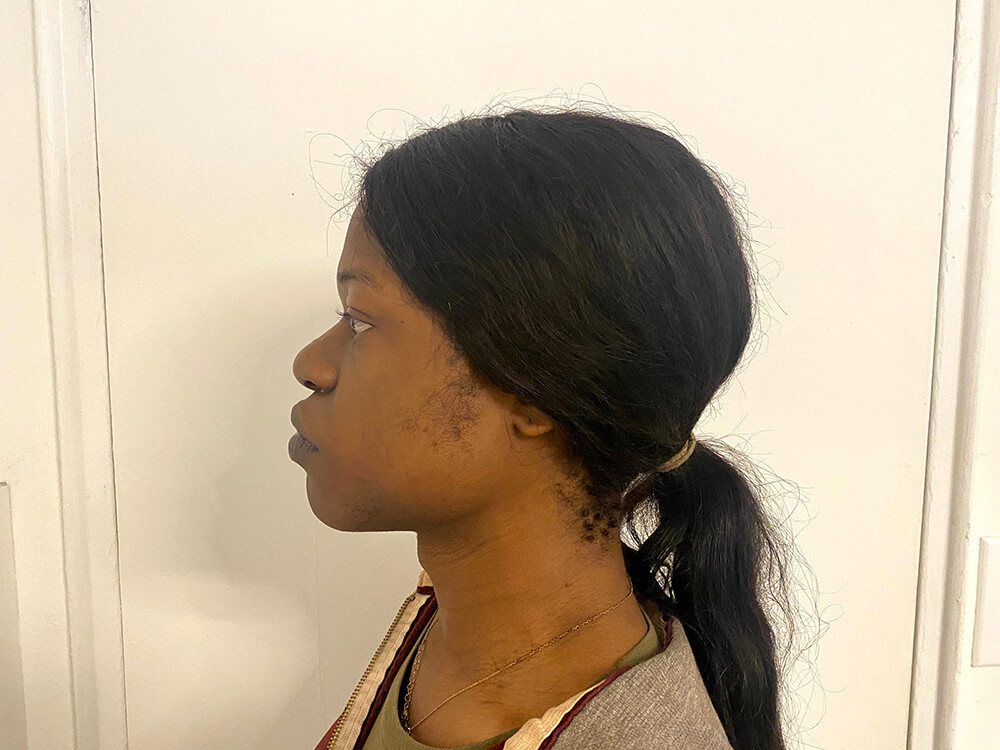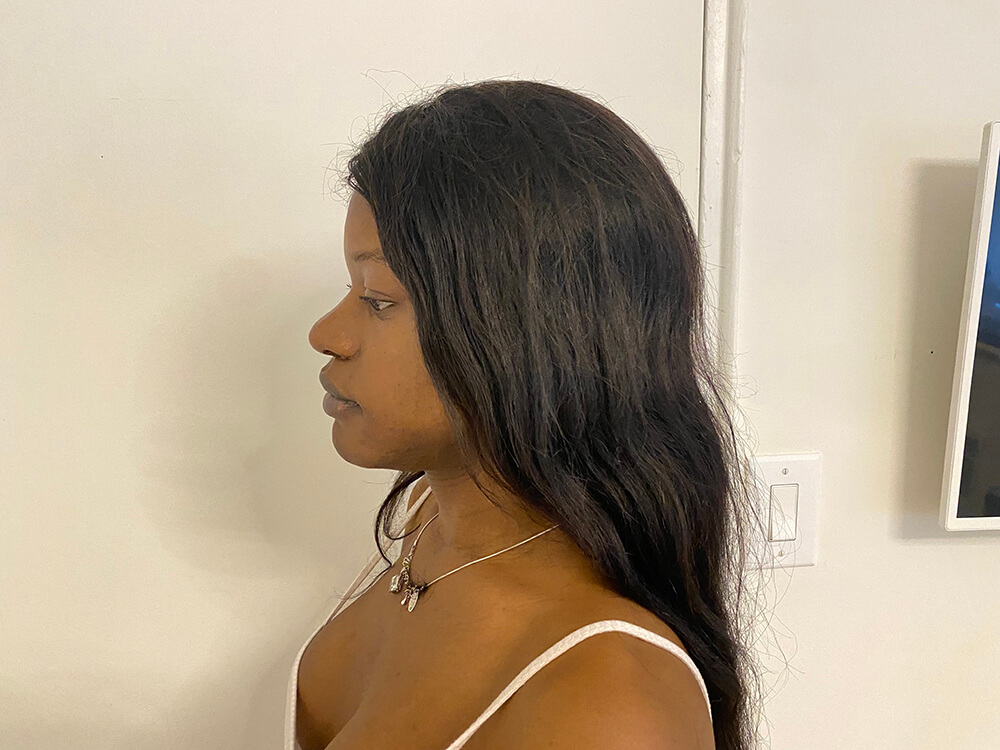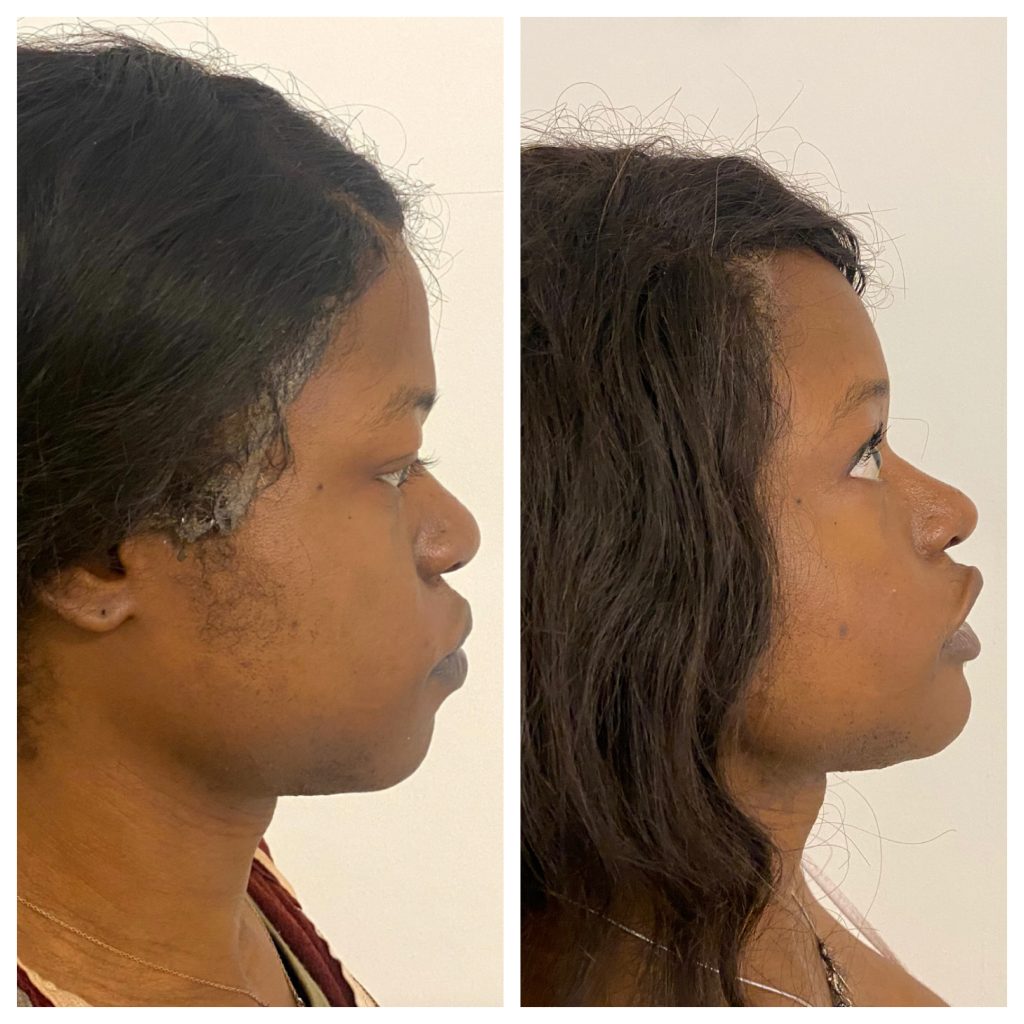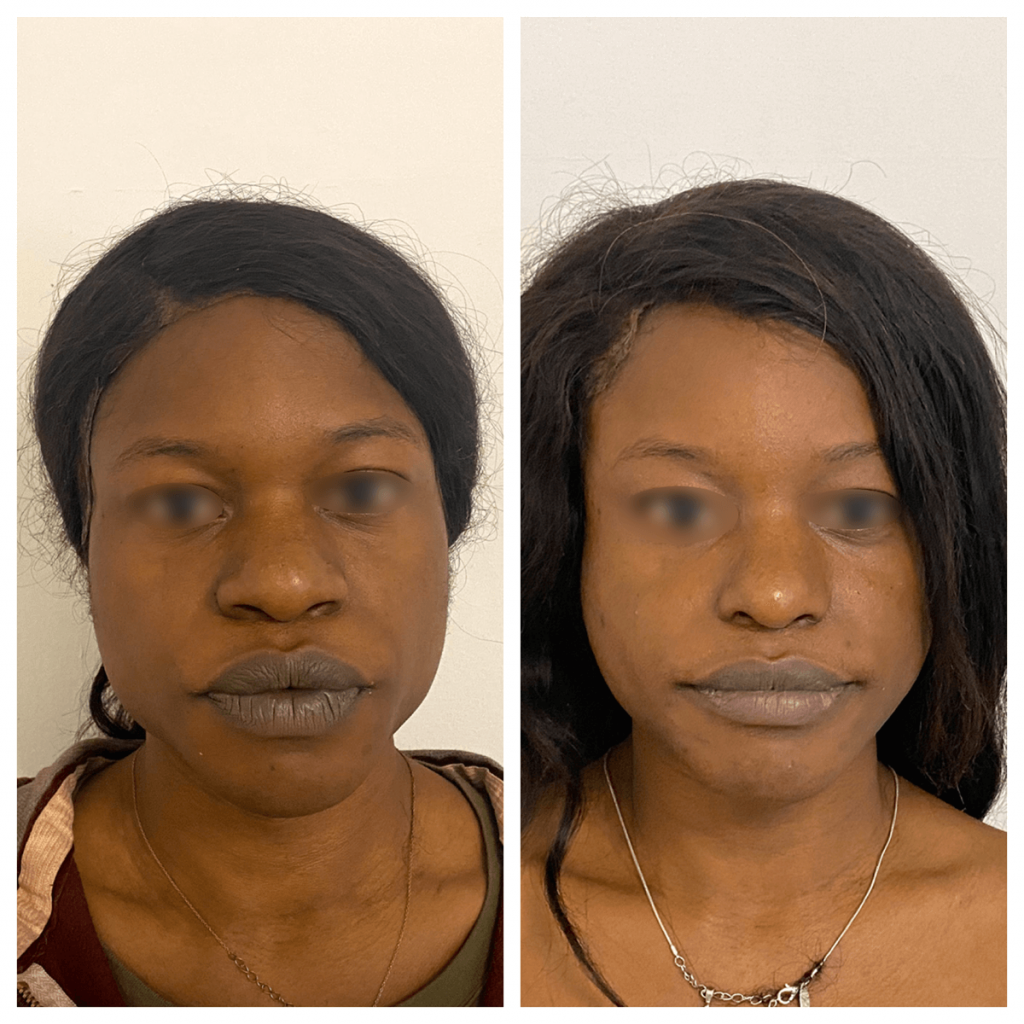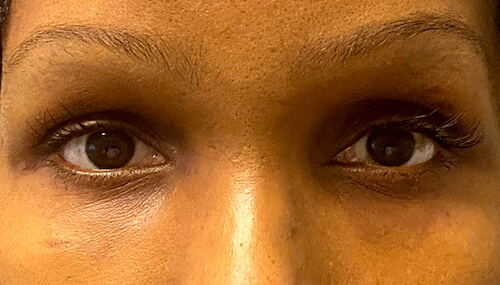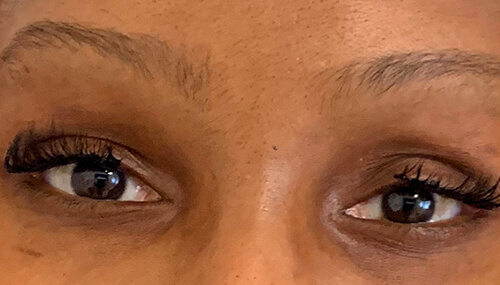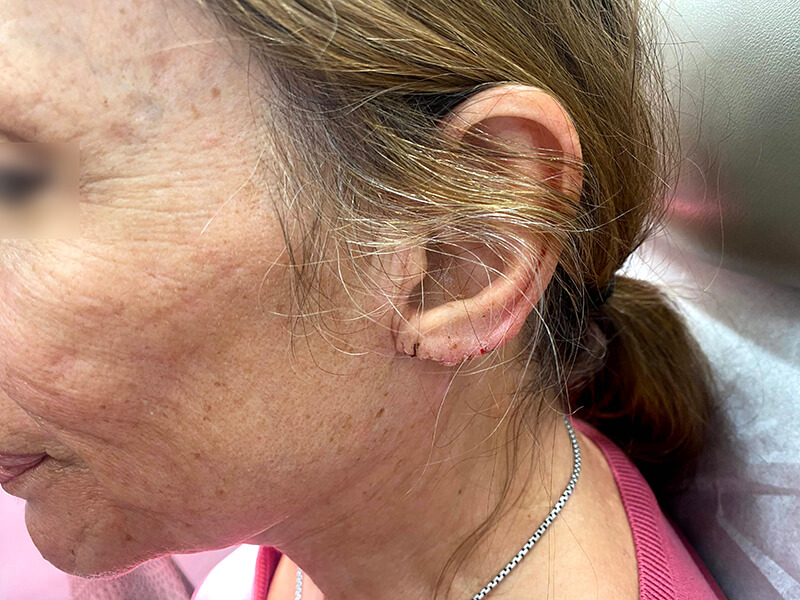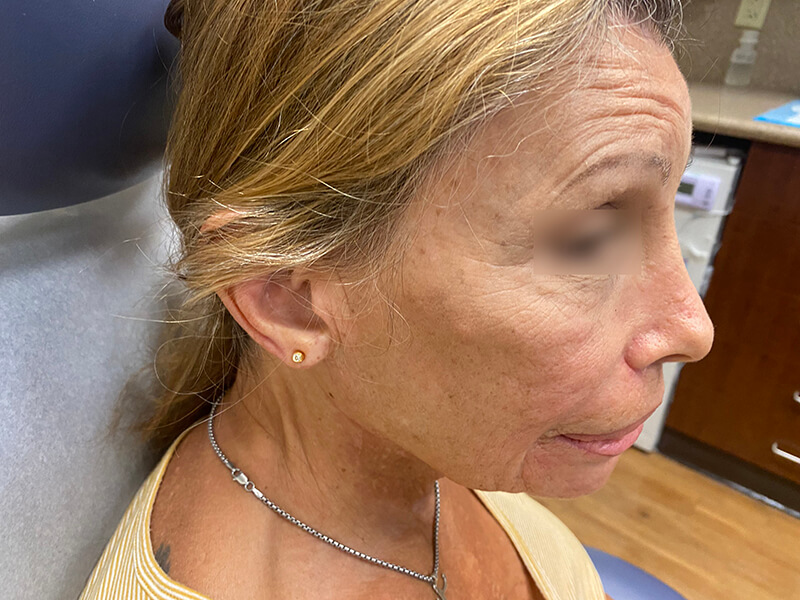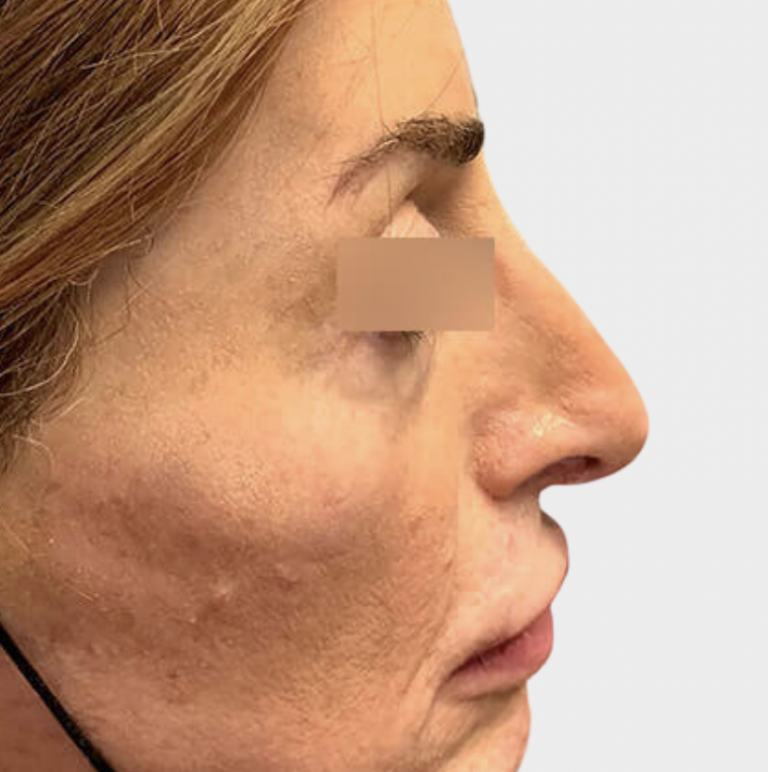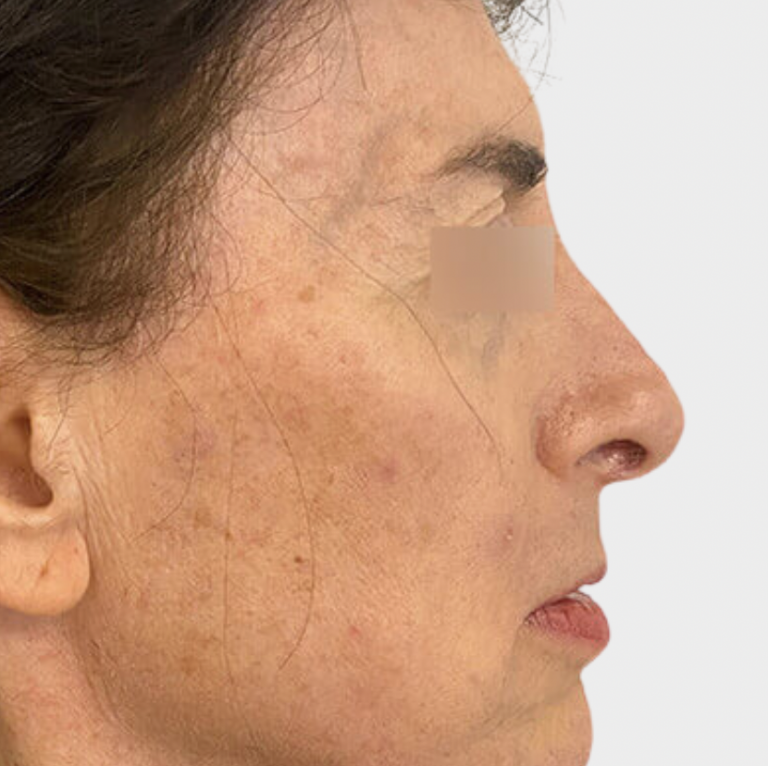Facial feminization, or FFS, are a series of procedures designed to help soften your appearance by altering both the facial skeleton and soft tissue. Skeletal foundation surgery is imperative for long term, naturally appearing results and are best performed by a facial surgical specialist.
Adam’s Apple Reduction (Tracheal Shave)
A tracheal shave, also known as thyroid cartilage reduction or Adam’s apple reduction, is a surgical procedure used to reduce the size of the thyroid cartilage, commonly referred to as the Adam’s apple. This procedure is often sought by individuals who wish to have a less prominent Adam’s apple for cosmetic reasons, including transgender women who desire a more feminized neck profile as part of their gender transition.
The surgery is typically performed under general anesthesia and involves making a small incision under a stealthy chin crease and then tunnel down to where the thyroid cartilage is located. Our Surgeons then carefully shave down the cartilage to reduce its size without affecting the vocal cords. The incision is usually placed in a natural skin crease to minimize visible scarring. Recovery time can vary, but most people are able to return to normal activities within a few days, although care must be taken to avoid strenuous activity that could impact the neck area.
Does Tracheal Shave affect the Voice?
A tracheal shave, when performed correctly, is generally designed to reduce the size of the Adam’s apple without affecting the vocal cords. However, there is some risk associated with the procedure that could potentially impact the pitch of the voice.
Surgical Precision: The closeness of the thyroid cartilage to the vocal cords means that any surgical error or excessive removal of cartilage can potentially damage the vocal cords or their function.
Swelling: Postoperative swelling can temporarily affect the voice, usually resolving as the swelling subsides.
Scar Tissue: In rare cases, the formation of scar tissue can also affect vocal cord function, leading to changes in the voice.
Our skilled surgeons perform a tracheal shave while taking great care to avoid the vocal cords and minimize risks.
Endoscopic Vocal Cord Visualization for Patients in the Performing Arts
An endoscope assisted tracheal shave is a more advanced and minimally invasive approach to performing a tracheal shave, aimed at reducing the size of the Adam’s apple. This technique uses an endoscope—a small camera and light attached to a flexible tube, allowing the surgeon to view the internal structures while simultaneously reducing the thyroid cartilages, thereby minimizing the risk of vocal cord destabilization. Dr. Reitzen is double-board certified in Otolaryngology and Facial Plastic Surgery and is highly skilled in endoscopy.
Brow Lift (Browplasty)
Brow lifting surgery can be particularly significant for transgender patients, especially for transgender women, as it helps align their facial features more closely with feminine norms, enhancing gender expression and potentially improving psychological well-being.
Importance of Brow Lifting in Transgender Patients
Facial Feminization: In transgender women, a brow lift is often part of broader facial feminization surgery (FFS). The male brow is typically flatter and more prominent with a lower position over the orbital rim, whereas the female brow is arched higher and positioned above the orbital rim. Lifting and reshaping the brow can help soften and feminize the overall appearance of the face.
Psychological Impact: For transgender individuals, surgeries like brow lifting can have profound psychological benefits, including increased self-esteem and better social integration, which are crucial aspects of the transition process.
Techniques Used
The choice of technique may vary based on individual needs, but the goal is to achieve a more rounded and elevated brow, which is typically perceived as more feminine:
Coronal Brow Lift: While undergoing orbital and brow bone reduction and brow lift may also simultaneously be performed. Sutures are placed to suspend both the medial and lateral brows creating a more feminine and youthful look.
Temporal Brow Lift: This technique might be used when specific lateral adjustments are needed, helping to elevate the outer segments of the brow to create a more arched appearance, which is often desired in feminization procedures.
Direct Brow Lift: Less commonly used due to more visible scarring, this method might be suitable for patients who require significant lifting and have forehead wrinkles that can camouflage the scars.
Combination with Other Procedures: Brow lifts in transgender patients are often performed in conjunction with other facial feminization procedures like hairline lowering, rhinoplasty, or forehead contouring to achieve a more comprehensive transformation.
Surgeon’s Experience: It’s crucial for transgender patients to choose surgeons experienced in transgender facial surgery, our specialists understand the unique anatomical and aesthetic needs.
For transgender patients, a brow lift is more than a cosmetic procedure; it’s a step towards aligning their external appearance with their gender identity. It requires thoughtful planning and a tailored approach to ensure the outcomes not only enhance physical appearance but also support the individual’s transition and overall well-being.
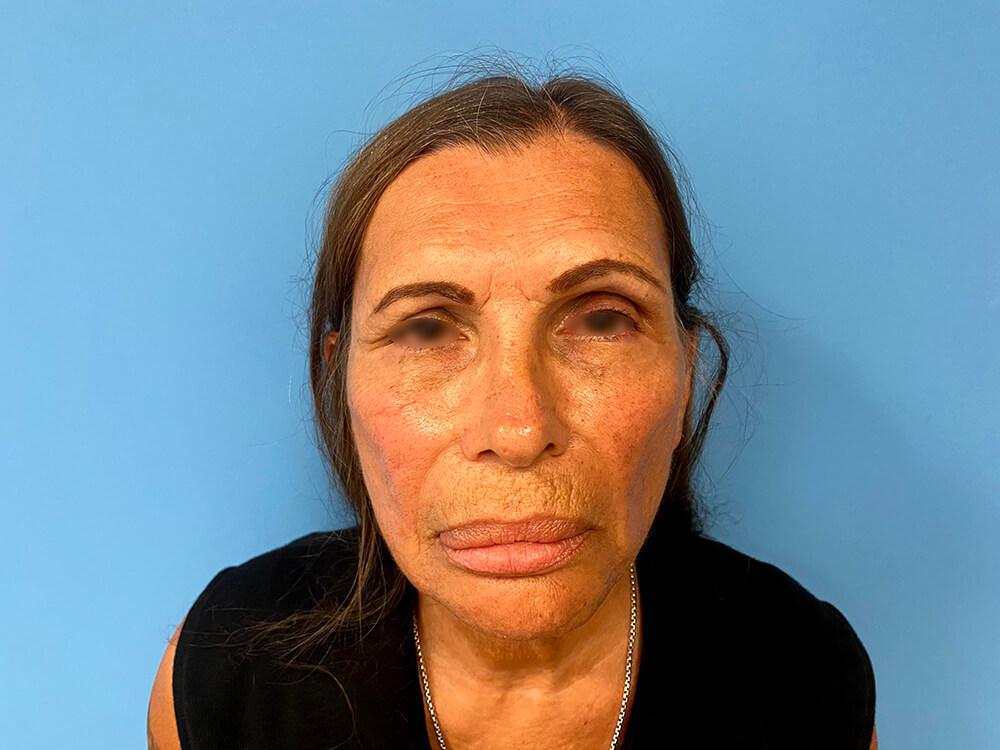
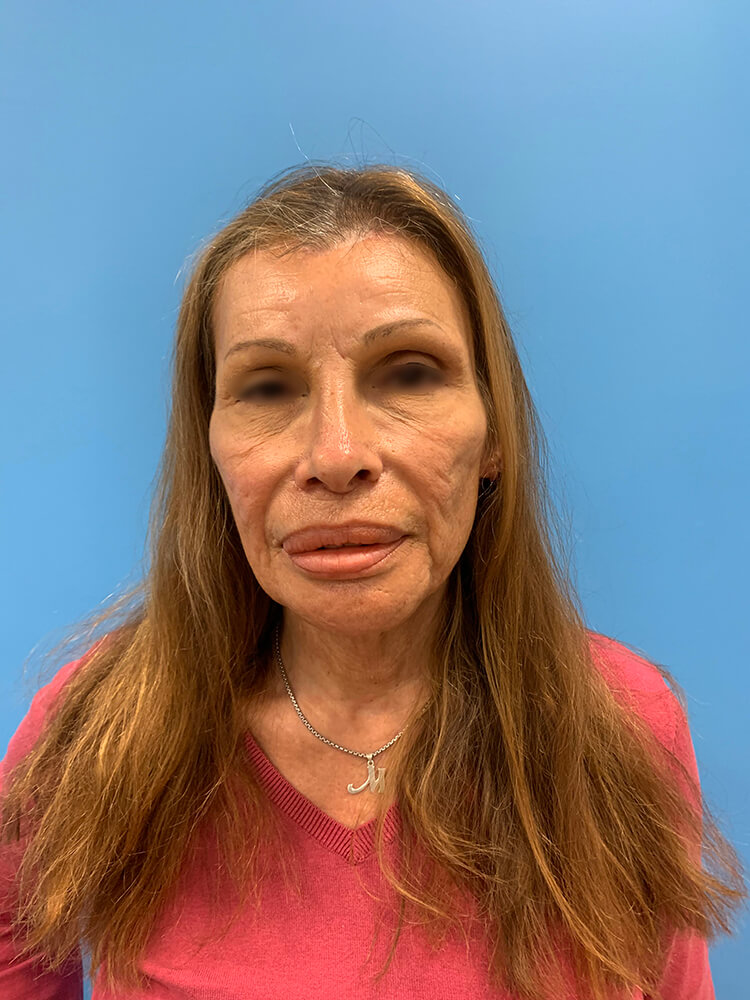
Cheek Enhancement (Augmentation & Reduction)
Fat grafting for cheek augmentation can be a particularly effective technique for transgender women seeking facial feminization. This procedure not only enhances the cheekbones but also softens and feminizes the overall facial features by adding volume in a natural-looking way. Here’s a deeper look into how fat grafting works for cheek augmentation in transgender women and the specific benefits it offers in the context of facial feminization.
How Fat Grafting Works
Harvesting: Fat is harvested from the patient’s own body, typically from areas with excess fat such as the abdomen, thighs, or hips. This aspect of the procedure can be doubly beneficial as it also contours the areas where fat is removed.
Processing: The harvested fat is then processed and purified. This step involves separating the viable fat cells from the fluid and other components.
Injection: The purified fat is carefully injected into the cheeks at various depths and points to achieve the desired volume and contour. The surgeon can sculpt the face by placing fat in specific areas that enhance femininity, such as the upper cheekbones to create a rounded, soft appearance typical of female facial structures.
Benefits for Transgender Women
Natural Results: Since the fat used comes from the patient’s own body, the results are typically very natural-looking. The texture and feel of fat are more similar to normal facial tissues compared to synthetic materials.
Dual Benefit: The procedure provides the dual benefit of reducing fat in unwanted areas while enhancing facial features, helping achieve a more typically feminine silhouette both in the face and potentially in the body.
Long-lasting: While some of the injected fat may be reabsorbed by the body over the first few months, the remaining fat can provide long-lasting results. Many patients see a significant portion of the fat survive long term, which can make this a more permanent solution compared to fillers.
Safety: Because the material injected is the patient’s own fat, there is no risk of allergic reaction or rejection by the body, which can be a concern with synthetic implants or certain fillers.
Minimal Scarring: Fat grafting involves only small incisions at the site of fat removal and tiny injection points on the face, which usually heal with minimal to no visible scarring.
Considerations
Variability in Results: The success of fat grafting can depend on how well the fat cells survive after transfer. Some patients might require multiple sessions to achieve their desired outcomes, as typically 30-50% of the transferred fat may not survive long term.
Recovery: The recovery from fat grafting can involve swelling and bruising at both the donor and recipient sites. Recovery time can vary, but most swelling typically subsides within a few weeks.
Skill of Surgeon: The technique and experience of the surgeon play a crucial role in the success of fat grafting. It’s important for transgender women to choose surgeons experienced in both facial feminization techniques and fat grafting for optimal outcomes.
For transgender women, fat grafting for cheek augmentation can be a compelling choice as part of a broader facial feminization strategy. It offers effective, natural-looking results and can be tailored to meet individual aesthetic goals. As with any cosmetic procedure, thorough consultation with a knowledgeable and experienced surgeon is crucial to ensure safety and satisfaction with the results.
Chin Recontouring (Genioplasty)
Overview of Reduction Genioplasty
Reduction genioplasty involves reshaping or reducing the chin bone to better align with feminine facial aesthetics. The procedure can vary depending on the initial shape and size of the chin and the desired outcome but generally involves:
Bone Removal or Shaving: The surgeon shaves off parts of the mandibular bone to reduce the chin’s prominence. This can include reducing the height and/or width of the chin to achieve a softer and more rounded appearance.
Bone Sliding: In some cases, the surgeon may cut through the chin bone, allowing it to be moved and secured in a new position that enhances the feminine appearance of the lower face. This might involve shortening the chin or changing its projection.
Advanced Techniques in Genioplasty – 3D Imaging and Planning: Modern surgical planning for genioplasty often involves 3D imaging techniques. These allow surgeons to visualize the outcomes before the actual surgery, offering both the surgeon and the patient a clear picture of the expected results. This technology helps in planning the precise cuts, movements, and final positioning of the chin bone or implants.
Combination Procedures: Genioplasty is frequently performed in conjunction with other facial feminization procedures like rhinoplasty, cheek augmentation, and jaw contouring. This integrated approach ensures that changes to the chin harmonize with other facial adjustments to achieve a cohesive and naturally feminine appearance.
Custom Implants: For implant genioplasty, advances in medical technology have made it possible to create custom implants tailored to the specific anatomical requirements and aesthetic desires of the patient. These implants are designed from patient-specific 3D scans, ensuring a perfect fit and more natural-looking results.
Benefits of Reduction Genioplasty for Transgender Women
Enhanced Feminine Appearance: By adjusting the chin to be less prominent and more rounded, reduction genioplasty can significantly feminize the lower face, helping to harmonize facial features and improve facial balance.
Improved Confidence and Social Perception: These aesthetic changes can have a profound impact on self-esteem and how individuals are perceived and treated in social settings.
Permanent Results: Unlike some other cosmetic procedures, the results of a reduction genioplasty are permanent, providing long-lasting benefits.
Considerations and Risks
Recovery: The recovery period can involve swelling, discomfort, and a temporary change in sensation in the chin and lip areas. Normal activities can usually resume within a couple of weeks, though complete healing might take several months.
Potential Complications: As with any surgery, there are risks of complications such as infection, nerve damage, or asymmetry. There is also the risk of dissatisfaction with aesthetic outcomes, which might necessitate revision surgery.
Revision Surgeries: In some cases, as the swelling fully subsides and the tissues settle, minor asymmetries or aesthetic concerns not initially apparent might become visible, necessitating revision procedures. These are typically less extensive than the initial surgery and are performed usually 6-12 months after the initial surgery. Long lasting fillers our fat transfers may also play a role in improving minor asymmetry.
A chin strap is placed postoperatively to maintain support for the chin during healing. The soft tissue may remain swollen for at least 2-3 months as the chin is the most gravity dependent part of the face. You will be instructed to wear the chin brace for at least 3 weeks during the healing process.
Eyelid Surgery
Excess skin of the eyelids can create a heaviness to the look of the eyes, resulting in a tired demeanor. The skin and fat can be reduced and or repositioned to help improve the overall look and openness of the eye.
The angle of the corner of the eye can be resuspended in a canthoplasty procedure, resulting in the desired “cat eye” many of trans patients enjoy.
Facelift
A facelift involves elevating the soft tissues and resuspending them in a more youthful feminine position. In addition, excess skin can be removed, and the folds and jowl can be softened. The incision are hidden in the shadows of the face around the ear. A neck-lift is often combined to help perfect the contour of both the upper and lower parts of the face.
Feminizing Earlobe Reduction
Feminizing earlobe reduction is a cosmetic procedure that transgender women might consider as part of their facial feminization. Although less commonly discussed than surgeries like rhinoplasty or genioplasty, earlobe reduction can play a significant role in subtly enhancing feminine facial features. This procedure adjusts the size and sometimes the shape of the earlobes, making them smaller and more proportionate to the size and shape typically perceived as feminine.
Reasons for Feminizing Earlobe Reduction
Proportion and Symmetry: Women’s earlobes are generally smaller and less elongated compared to men’s. Reducing the size of the earlobes can help achieve a more delicate and proportionate look that aligns with other feminized facial features.
Aesthetic Balance: Large or stretched earlobes can distract from other facial feminization procedures. Reducing the earlobes can bring a more balanced and cohesive appearance to the face.
Jewelry and Presentation: Smaller earlobes can enhance the way earrings and other jewelry are displayed, which is often an important aspect of feminine presentation.
Procedure Details
Technique: The procedure typically involves removing a segment of the earlobe and then suturing the remaining parts together. This can be done under local anesthesia and is relatively quick, usually taking less than an hour.
Incisions and Scarring: Incisions are made along the natural creases of the earlobes to minimize visible scarring. Because the earlobes heal relatively well and quickly, scars are usually inconspicuous.
Customization: The procedure can be tailored to the individual’s desires and the specific aesthetic goals discussed with the surgeon. This might involve not just reducing the size but also reshaping the earlobe to achieve a particular look.
Recovery and Care
Recovery Time: Recovery is typically quick, with minimal discomfort that can be managed with over-the-counter pain relievers. Patients can often return to normal activities within a day, though care should be taken to avoid exertion that might stress the sutures.
Postoperative Care: It’s important to keep the area clean and dry. Follow-up visits are necessary to ensure proper healing and to remove sutures if they are not self-dissolving.
Results: The results are immediate, though full healing and the final shape of the earlobes will be evident once the swelling subsides, usually within a few weeks.
Considerations and Risks
Infection: As with any surgery, there is a risk of infection, which can be minimized by proper sterile technique and postoperative care.
Asymmetry: There’s a risk of asymmetry, which can be corrected with minor revisions if necessary.
Expectations: It’s crucial to have realistic expectations about the results and to discuss these thoroughly with the surgeon during the pre-operative consultations.
Feminizing earlobe reduction, though a smaller scale procedure compared to other facial feminization surgeries, can significantly contribute to the overall feminization of the face, helping transgender women achieve a more harmonious and desired appearance. It’s a testament to the detailed and personalized approach necessary in the journey of transgender individuals seeking to align their physical appearance with their gender identity.
Forehead Reduction and Contouring Surgery
There are many anatomical differences between the masculine and feminine forehead. The forehead is often the area creating most dysphoria in our trans patients, particularly when viewed in side profile. Masculine foreheads are more convex, and have prominent orbital rims and bulging frontal sinus. The surgeon must effectively address all of these parts to create a soft, feminine profile.
Frontal Sinus
The frontal sinus is the area directly above and between your two eyes. As we grow from child to adult, this part of the skull fills with air and mucosa. In males, it is often larger and more protrusive. The frontal sinus has a thin layer of bone (called the anterior table) that is about 3-4mm thick. Underneath this is the air and mucous filled sinus) which drain into your nose. There is an additional thin layer of bone (posterior table) which protects the brain and does not need to be remodeled.
The goal for your surgeon is to create almost a vertical line from the base of the bridge of the nose towards the scalp. This can be accomplished by either burring down (type 2) the prominent bone of the anterior table, or by setting the bone back further into the sinus cavity (type3). Since the thickness of the anterior table is only 3 – 4mm, the surgeon is limited by how much they can reduce the bone without doing a type 3 setback. Many surgeons are uncomfortable with doing a proper removal and setback and you should ask them if they routinely do this. A type 3 setback involves the entire anterior table bone flap, remodeling it from the inside with the high speed burr, reducing the frontal sinus septum (bone that separated the 2 sides internally) and then fixating it back in a setback position. Dr. Bastidas MD uses a resorbable plate to set the bone back that will dissolve over the course of 1 – 2 years.
Orbital Rims
The top part of the eye socket is very prominent in a masculine face and much less convex in a feminine face. The eye socket is also wider and taller laterally in the feminine architecture. After exposing the area through the incision described above, we can soften these features using a high speed burr thus allowing us to sculpt the desired look. These changes are immediately appreciated postop and especially visible from the side profile.
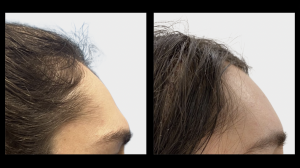
Hairline Advancement
The approach to the forehead for remodeling requires a long incision for access. This incision can be placed either an inch behind your hairline or directly in front of it depending on your goal. If you would like to lower your hairline then the incision must be placed directly in front of it. This will allow your surgeon to effectively remove excess forehead skin while simultaneously advancing the hair bearing skin forward.
The temples are often area where some hair loss has typically occurred. This may be dependent on the timing of when you started taking estrogen. Hormones are protective against male pattern baldness and the early you start the the better. The widows peak area can be improved by advancing the hair bearing skin creating a more youthful and feminine hairlines.
The scalp tissue is very vascular and its not uncommon to bleed from it. To control bleeding we often inject adrenaline prior to making incisions. This allows the blood vessels to clamp down and reduce blood loss. In addition, surgeons may apply temporary surgical clips to the area that will further reduce bleeding of the skin edges.
The scalp skin is typically tight. Feel your own scalp and try to pinch the skin together to see my point. The skin doesn’t move much and will restrict how much we can lower the forehead. The deeper scalp tissue however, once released, can allow more forward movement particular in the areas over the widows peak. To accomplish this your surgeon can release the skin from the back of the scalp by dissecting wide and far (almost lifting the entire scalp). The deep scalp has a loose tissue plane that is bloodless (subgaleal) and allows safe and easy dissection. The hair bearing scalp is then advanced to its maximum front position while simultaneously determining how much hairless forehead skin can be safely removed.
Excess tension on the closure can lead to thick scarring, known as hypertrophic scars. Similar to a facelift, the goal is to create thin, blended facial scars, so your surgeon must choose just the right amount of tension during closure. The skin is closed in layers to allow for the best scarring and most efficient healing. I typically use a buried, resorbable suture underneath the skin (in the galeal layer) and follow this with a resorbable suture that connects the top layer of the skin together. Some surgeons choose to use staples for this part which is fine as long as the staples are removed by postop day #7.
Typically 1/2 to 1 inch of hairline advancement can be safely accomplished. The scars are minimized with proper timing of suture/staple removal, non surgical scar treatments such as silicone lotions, steroid injections and laser where applicable. Massaging the scar may also help reduce the thickness of it (ask your surgeon when to begin). If you have as history of keloids, please inform your surgeon as this would be need to be addressed with early steroid injections at the time of surgery and during the recovery period.
Jaw Contouring (Reshaping or Tapering)
Mandible angle reduction, also known as jaw contouring, is a significant surgical procedure within the scope of FFS aimed at transgender women. This surgery is designed to alter the shape of the lower jaw to create a more feminine facial profile. Typically, male jawlines feature a sharper, more pronounced angle with greater width at the mandible, which can give the face a more squared appearance. In contrast, a feminine jawline usually has a softer, rounded, and narrower shape.
Overview of Mandible Angle Reduction
Surgical Technique: The procedure involves making incisions inside the mouth to access the jawbone, minimizing visible scarring. The surgeon then reshapes the mandible by shaving or cutting off part of the bone at the angles of the jaw, and sometimes along the lower edge, to reduce width and create a smoother contour.
Goals of Jaw Contouring for Transgender Women
Feminization of the Jawline: By reducing the width and prominence of the jaw angles, the face achieves a more oval or rounded shape, which is often perceived as more feminine.
Harmony and Balance: The procedure aims to bring harmony and balance to the facial features, making the jawline more congruent with other feminized features such as a refined chin and cheekbones.
Benefits of Mandible Angle Reduction
Aesthetic Enhancement: This surgery can dramatically change the lower face, enhancing the overall aesthetic and contributing to a more traditionally feminine appearance.
Increased Confidence: For many transgender women, having a facial structure that aligns with their gender identity can significantly boost self-esteem and comfort in social situations.
Permanent Results: Unlike non-surgical options, the changes made during mandible angle reduction are permanent, providing lasting alignment with one’s gender identity.
Considerations and Risks
Dietary Adjustments: Patients are usually required to follow a soft or liquid diet for the initial weeks post-surgery to prevent stress on the jaw and facilitate healing. Gradual reintroduction of normal foods occurs as healing progresses and as recommended by the surgeon.
Recovery Time: Recovery can vary but generally involves swelling and discomfort for several weeks. Patients typically need to adhere to a soft diet while the incisions inside the mouth heal.
Nerve Damage: There is a risk of temporary or permanent nerve damage, which can affect sensations or movement in the lower lip and chin area.
Asymmetry and Aesthetic Risks: There’s always a risk of asymmetry, which might require further surgical adjustments. Also, there is the potential for dissatisfaction with the aesthetic outcome.
Recovery and Postoperative Care
Immediate Postoperative Care: Patients often need to stay in a hospital for at least one night following surgery. Ice packs and medication are used to manage swelling and pain.
Long-Term Care: Regular follow-up visits are essential to monitor healing. Patients are advised to avoid strenuous activities that could impact the jaw and to follow a soft diet to facilitate healing.
Potential Need for Revision: Some patients may require revision surgeries to correct or refine the shape of the jaw if the initial results are not satisfactory or if complications occur.
Lip Lift and Lip Filling
Plush, pouty lips are often considered feminine and alluring. The volume of both the upper and lower lips can be expanded using your own fat. Fat can be removed from your belly area and injected to your lips to act as permanent filler. Fat transfers may partially resorb requiring additional fat grafting to achieve your exact goal.
Lip Lifts have gained popularity recently as a way to show more red lip (vermillion) and also more of your central teeth. A lip lift is a cosmetic procedure often included in facial feminization surgery for transgender women. It aims to enhance the overall femininity of the face by altering the lip shape and the area between the upper lip and the nose, known as the philtrum. This procedure can help create a more youthful and traditionally feminine appearance by increasing the visibility of the upper teeth when the lips are slightly parted, which is a feature typically more pronounced in female faces.
General Aesthetic Standards
Typically, the ideal length of the upper lip (measured from the base of the nose to the top of the lip) for women is about 11 to 13 millimeters. This measurement is considered aesthetically pleasing in many cases because it allows for a proportionate balance between the upper and lower facial features and contributes to a youthful appearance. A shorter upper lip also tends to reveal a slight amount of the upper teeth (about 1 to 3 millimeters) when the mouth is slightly open and at rest, which is often associated with a youthful and feminine look.
Factors Influencing Ideal Lip Length
Facial Proportions: The ideal lip length should be in harmony with other facial features. For example, someone with a longer face may have a slightly longer ideal lip length, whereas someone with a more rounded face might benefit from a shorter upper lip to enhance facial balance.
Ethnic Variations: Different ethnic groups naturally have varying lip and facial proportions. Surgeons take these differences into account to ensure that any modifications respect and enhance the individual’s natural ethnic features.
Age: With aging, the lip length tends to increase due to gravitational and structural changes in the facial tissues. Younger individuals naturally have shorter upper lips, so procedures aimed at restoring or achieving youthfulness often focus on reducing the upper lip length.
Overview of a Lip Lift
Procedure Details: A lip lift involves removing a small strip of skin just below the nose, effectively shortening the philtrum. This lifting effect increases the prominence of the upper lip, making it appear fuller and more defined. The incision is usually made at the base of the nose, hiding the scar within the natural creases of the skin.
Goals of a Lip Lift for Transgender Women
Enhanced Lip Fullness: Through elevating the position of the upper lip, a lip lift can make the lips appear fuller, a characteristic often associated with a youthful, feminine face.
Reduced Philtrum Length: Women generally have a shorter philtrum than men. Reducing the philtrum length can feminize the mid-face region and enhance the overall aesthetic balance between facial features.
Increased Tooth Show: A subtle but important aspect of femininity in smile aesthetics is the exposure of the upper teeth. A lip lift can help achieve this effect, making the smile appear more vibrant and feminine.
Benefits of a Lip Lift
Immediate and Lasting Results: The results of a lip lift are immediately noticeable and can significantly enhance facial femininity. The effects are also permanent, unlike temporary solutions such as fillers.
Minimal Downtime: Recovery from a lip lift is relatively quick compared to more invasive surgeries. Most patients can return to normal activities within about a week.
Subtle but Significant Impact: Although the changes are localized, they can dramatically alter the perception of the face, contributing to a more harmonious and youthful appearance.
Considerations and Risks
Scarring: While the scar is typically hidden along the base of the nose, there is a risk of visible scarring, especially if the incision does not heal properly or if the patient is prone to keloids.
Asymmetry: There is a risk that the lift could result in asymmetry, which might require further corrective procedures.
Nerve Damage: There is a small risk of nerve damage that could affect sensory or motor functions in the lip, though this is rare.
Infection: As with any surgical procedure, there is a risk of infection, which can be managed with proper postoperative care and hygiene.
Recovery and Postoperative Care
Care of the Incision Site: It’s important to keep the incision site clean and dry. Patients may need to apply topical antibiotics or other prescribed treatments to aid in healing.
Swelling and Bruising: Some swelling and bruising are normal but typically resolve within a couple of weeks.
Diet and Activities: Patients might need to limit certain facial expressions and avoid strenuous activities that could strain the surgical site during the initial recovery period.

Neck Lift / Liposuction
A neck lift, also known as a lower rhytidectomy, is a cosmetic procedure that can be an important part of facial feminization for transgender women. This surgery aims to enhance the appearance of the neck by reducing excess skin and fat, and tightening the underlying muscles. It can significantly rejuvenate the lower face and neck area, contributing to a smoother, more refined, and typically feminine silhouette.
Goals of a Neck Lift for Transgender Women
Contouring the Jawline and Neck: By removing excess skin and fat and tightening muscles, a neck lift can help define the jawline and create a more angular and feminine neck contour.
Reducing the Appearance of Aging: The procedure can address signs of aging like wrinkles and loose skin, which are often more pronounced in the neck area.
Enhancing the Outcome of Other Feminization Surgeries: When combined with other facial feminization procedures such as a facelift or jaw contouring, a neck lift can provide more comprehensive and harmonious results.
Procedure Details
Incisions: Typically, incisions are made around the ears and sometimes under the chin. These locations help to hide surgical scars within natural skin creases or areas that are less visible.
Techniques: The surgery may involve liposuction to remove excess fat, cervicoplasty to remove excess skin, and platysmaplasty to tighten the neck muscles and remove or alter neck bands.
Duration and Anesthesia: A neck lift usually takes several hours and is performed under general anesthesia.
Benefits of a Neck Lift
Improved Aesthetic Balance: Tightening and contouring the neck can help balance facial features and contribute to a more youthful and feminine appearance.
Permanent Results: Unlike non-surgical tightening procedures, the results of a neck lift are long-lasting, although they do not stop the aging process.
Boost in Confidence: By aligning physical appearance more closely with gender identity, this procedure can significantly improve self-esteem and body image.
Considerations and Risks
Recovery: Recovery can take several weeks, during which swelling, bruising, and discomfort are common. Patients typically need to wear a compression garment to help reduce swelling and support the healing of the neck tissues.
Scarring: While scars are generally well-hidden, they are an inevitable part of the surgery. Proper care and following the surgeon’s instructions can minimize scar visibility.
Risks: Common surgical risks include infection, bleeding, and adverse reactions to anesthesia. There can also be specific risks like nerve injury, which may affect sensation or muscle function in the neck and lower face.
Recovery and Postoperative Care
Immediate Postoperative Care: Patients need to rest with their head elevated and may need assistance during the first few days after surgery.
Activity Restrictions: Strenuous activities and heavy lifting should be avoided for several weeks to ensure proper healing.
Follow-Up Visits: Regular appointments with the surgeon are necessary to monitor healing and address any concerns.
Rhinoplasty (Nasal Surgery)
The nose is the center of the face and so often an area of dysphoria for all patients. A masculine nose is often larger, broader, less rotated and often with less tip definition than a feminine nose. Using rhinoplasty techniques, a feminine nasal tip is sculpted to create a more angular, refined appearance. This may involve:
Dorsal Reduction
The nasal hump can be eliminated by shaving down the bone during surgery. The nasal bridge can also be lowered overall to create a more delicate appearing nose.
Nasal Tip
The tip of the nose is composed entirely or cartilage and soft tissue. The cartilages can be shaved to create less bulk, and also redirected and reshaped using suture techniques. Often cartilage grafts are required to help add structural support as well as additional projection to help create a smaller, more defined tip.
Nasal Bone Osteotomies
The nasal bones can be brought closer together my precisely fracturing them at their base and moving them closer together. This will create a more narrow appearing nose after it heals. The nasal bones heal within 4-6 weeks and permanent correction can be obtained.
Nostril Show / Alar Base Reduction
The nostril shape can be reduced and the alar base reshaped to create a more delicate appearing nose. This required an incision (and thus scar) around the edge of the nostrils which is well hidden in the crease.
Revision Surgery
We often see patients that are dissatisfied with their facial feminization results from other surgeons. We can offer revision FFS surgery to help improve your outcomes and resolve any remaining asymmetries or under-correction. The first step involves doing a complete examination and possible repeat CT scan imaging to determine the core of the problem. It is helpful if you can get the operative records and notes from your previous surgeon so we can have all the information necessary to determine the best plan of action.

